Date: 25/11/2022
Relevance: GS-2: Bilateral, Regional, and Global Groupings and Agreements involving India and/or affecting India’s interests.
Key Phrases: G20 presidency, Policy formulation, financing climate infrastructure, India Stack, South Asia’s agenda, re-imagine the shareholding structures of the IMF and World Bank, multicultural and multi-religious quasi-federal structure, G20 Sherpa.
Why in News?
- The moment of India’s ascent to the G20 presidency coincides with the country’s 75th year of Independence. This opportunity must not be frittered away.
- Together, the G20 members represent over 80% of the world’s GDP, 75% of international trade, and 60% of the population. There are a few wins possible for India.
Policy formulation:
- Traditionally, the presiding country usually comes up with its policy
formulation.
- For example, the Italian presidency’s agenda rested on the three pillars of people, planet, and prosperity.
- The Saudi presidency also had three objectives: empowering people, safeguarding the planet, and shaping new frontiers.
- Constituents of India’s policy formulation:
- Need for new windows for financing climate infrastructure:
- Using the G20, India should press the International Monetary Fund (IMF), the World Bank Group, and the Asian Development Bank to open new windows for financing climate infrastructure to support the Panchamrit goals.
- Traditionally, the IMF provides financial support for the balance of payments needs.
- But now even countries such as India, which are economically sound, need finances for investments in climate-related infrastructure.
- Unlike the World Bank, the IMF functions exclusively via grants. It is flushed with funds and is seeking avenues to invest.
- If India manages to persuade the IMF to open a window for climate financing, it would be significant.
- Roll out the India Stack on the global stage:
- India Stack is the world’s largest digital public utility and is growing by leaps and bounds.
- Some of its principal components are Aadhaar, UPI, eKYC, and DigiLocker. The PM of India has often been asked, in various global forums, to share the design and implementation framework of India Stack.
- If India does this using G20 as a platform, it will enable the country to be showcased on the global stage and other countries to leapfrog their systems. Showcasing India Stack would further enhance India’s prestige abroad.
- Putting India and South Asia’s agenda on the global scale:
- India could use the platform to push its agenda and South Asia’s agenda on a global scale — for example, by coming up with an alternative financial mechanism to SWIFT, which is a U.S. monopoly; and taking baby steps for making the rupee more international.
- Reform in the shareholder structure of IMF and World Bank:
- India should leverage the G20 to re-imagine the shareholding structures of the IMF and World Bank.
- This is easier said than done, but it is time to begin conversations around restructuring the World Bank and the IMF so that they bear fruit sometime in the future.
- The current structures of the World Bank and the IMF are at variance with the emerging world in general and India in particular.
- India can use the leadership to re-imagine the shareholding structure in such a way that it reflects its global aspirations and power position and also those of other emerging markets.
- Showcasing Indian culture:
- India, like the European Union, represents a multicultural and multi-religious quasi-federal structure.
- There are different States, or Europe-like countries, within India’s border, and has a rich culture.
- The G20 would be a good platform for India to showcase the multiple and myriad aspects of its composite culture so that the world begins to appreciate the richness and cultural tenacity of the country.
- Showcasing the soft power:
- This is a big moment for India to showcase and influence soft power abroad, as the brilliant and powerful diaspora is doing right now.
- This can be a great moment to bring together the power of the diaspora and the power of Indian culture on a single platform.
- The world needs an alternative to the U.S.’s soft power and culture, which have been ubiquitous for a long time.
- Tourism:
- India receives around 17 million-18 million tourists every year. Compare this to Las Vegas, a city in the U.S., which alone gets over 30 million tourists. India has a huge potential to boost tourism.
- Amitabh Kant, the IAS officer who was a key driver of initiatives such as ‘Incredible India!’ and ‘God’s Own Country’, is now the G20 Sherpa.
- The various G20 meetings should be held in the Top 25 destinations of India to power the tourism industry.
Conclusion:
- G20 is all about just one thing — reconciling the irreconcilable. If there is one country that has the stature to make this happen, it is India.
- The country has earned its stripes during tough external and internal times through its deft economic management (inflation is 11% and rising in the U.K.; 9% in the U.S., and 7% and falling in India).
- Further, the development and roll-out of COVID-19 vaccines in India were remarkable.
- India has justifiably earned global accolades for both these achievements and is thus well-positioned to beat into place a tough but necessary consensus on the G20 platform.
- If anyone can provide leadership and make this happen, it is India at this moment.
Source: The Hindu
Mains Question:
Q. "Through the G-20 presidency, India has the responsibility for bringing stability to a deeply divided multipolar world and crafting broader global responses to the challenges." Discuss.







